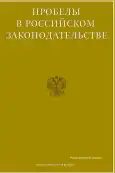Current Prospects for the Development of the Institute of Public-Private Partnership in the Russian Federation in the New Reality
- Authors: Melnikova D.A.1
-
Affiliations:
- Lomonosov Moscow State University
- Issue: Vol 15, No 6 (2022)
- Pages: 114-119
- Section: Articles
- URL: https://journals.rcsi.science/2072-3164/article/view/147722
- ID: 147722
Cite item
Abstract
Full Text
##article.viewOnOriginalSite##About the authors
Darya Alexandrovna Melnikova
Lomonosov Moscow State University
Email: melnikova-dariaa@mail.ru
master student, Higher School of State Audit Moscow, Russia
References
- The Constitution of the Russian Federation 12.12.1993 (with amendments and additions on 01.07.2020) // Rossiyskaya Gazeta. - 1993. - December 25; Official Internet portal of legal information http://www.pravo.gov.ru.
- Anishchenko E. V., Anishchenko A.V., Sovetov D. I. The risk of law enforcement error in the qualification of crimes in the field of economics // Problems of economics and legal practice. - 2021. - № 6.
- Anishchenko E. V. Capital outflow - a systemic threat to the sustainability of ensuring economic security of the Russian Federation // Problems of Economics and legal practice. - 2020. - Vol. 16, No. 4. - p. 1.4.
- Belitskaya, A.V. Legal regulation of public-private partnership / A.V. Belitskaya. Moscow: Statute, 2012. p.191.
- Bodarenko A.S. The role of public-private partnership in the innovative development of the Russian economy. In the collection: The collection of works of masters - 2019. Collection of articles. Moscow, 2019. pp. 90-96.
- Varnavsky, V. G. Public-private partnership in real estate - what is it? / V. G. Varnavsky // Real estate and Investments: Legal regulation: electronic scientific journal. 2009. № 4. URL: http://dpr.ru/journal/journal_39_14.htm.
- Zhidkov A. S. The essence and prospects of the development of public-private partnership mechanisms in the Russian Federation / A. S. Zhidkov, Yu. A. Koskina // NAUKOVEDENIE: online journal. 2016. Vol. 8. No. 3. Pp. 30-43.
- Ignatyuk, N. A. Public-private partnership: textbook / N. A. Ignatyuk. Moscow: Justicinform, 2012. p.480.
- Laktionov V.A. Terminology of the concept of "Public-private partnership" // Bulletin of the North Caucasus Federal University. 2020. No. 2 (77). pp. 86-92.
- Ryzhenkov I.S. Some forms of public-private partnership // Innovative science. 2016. No. 5-2 (17). pp. 268-270.
- Sergeev V.E., Antipova Yu.O. Classification of forms of public-private partnership. In the collection: Public and corporate procurement as a form of public-private partnership. collection of scientific articles. Editorial board: G.V.Degtev, I.P.Gladilina. Moscow, 2014. pp. 56-61.
- Sokolov S.L. Forms of public-private partnership in socially significant sectors of the economy // Siberian Financial School. 2012. No. 3 (92). pp. 56-61.
- Spiridonov A. A. Public-private partnership: the concept and prospects of improving legislative regulation / A. A. Spiridonov // Actual problems of socio-economic development of Russia. - URL: http://pppcenter.ru/29/novosti/smi-o-centre/19032010.html.
- Strelnikova L.M., Kovaleva E.M. The main forms of public-private partnership in Russia // In the collection: The formation of a market economy: theory and practice. collection of scientific articles. Orenburg, 2016. pp. 155-159.
- Chernihiv M. Partnership for development // Corporate Lawyer. No. 10. 2008. p.3.
Supplementary files








